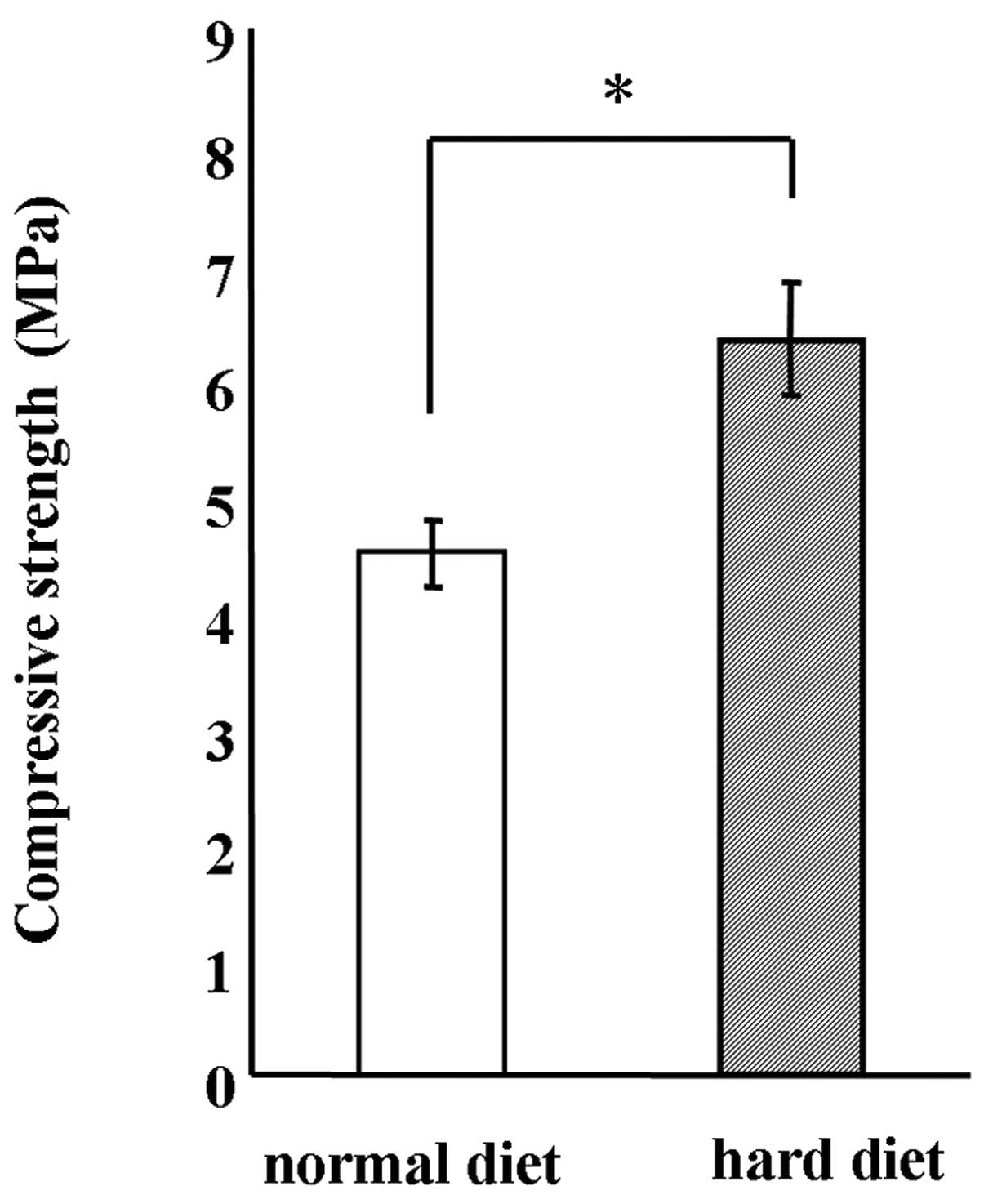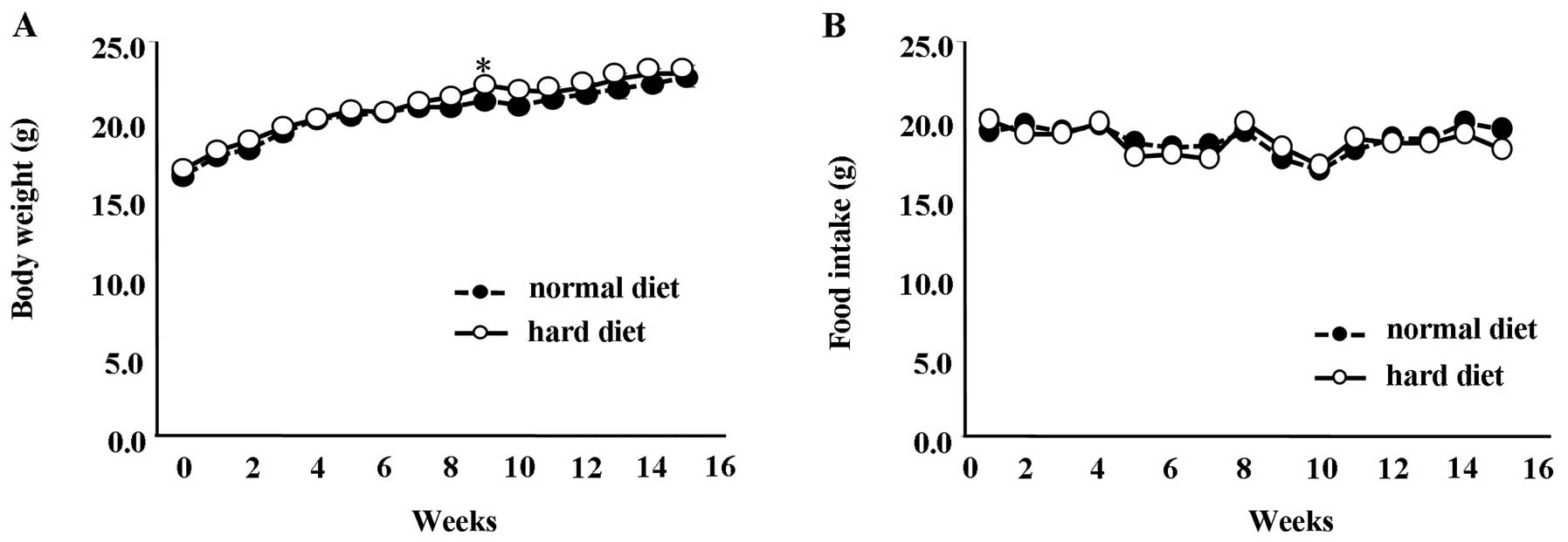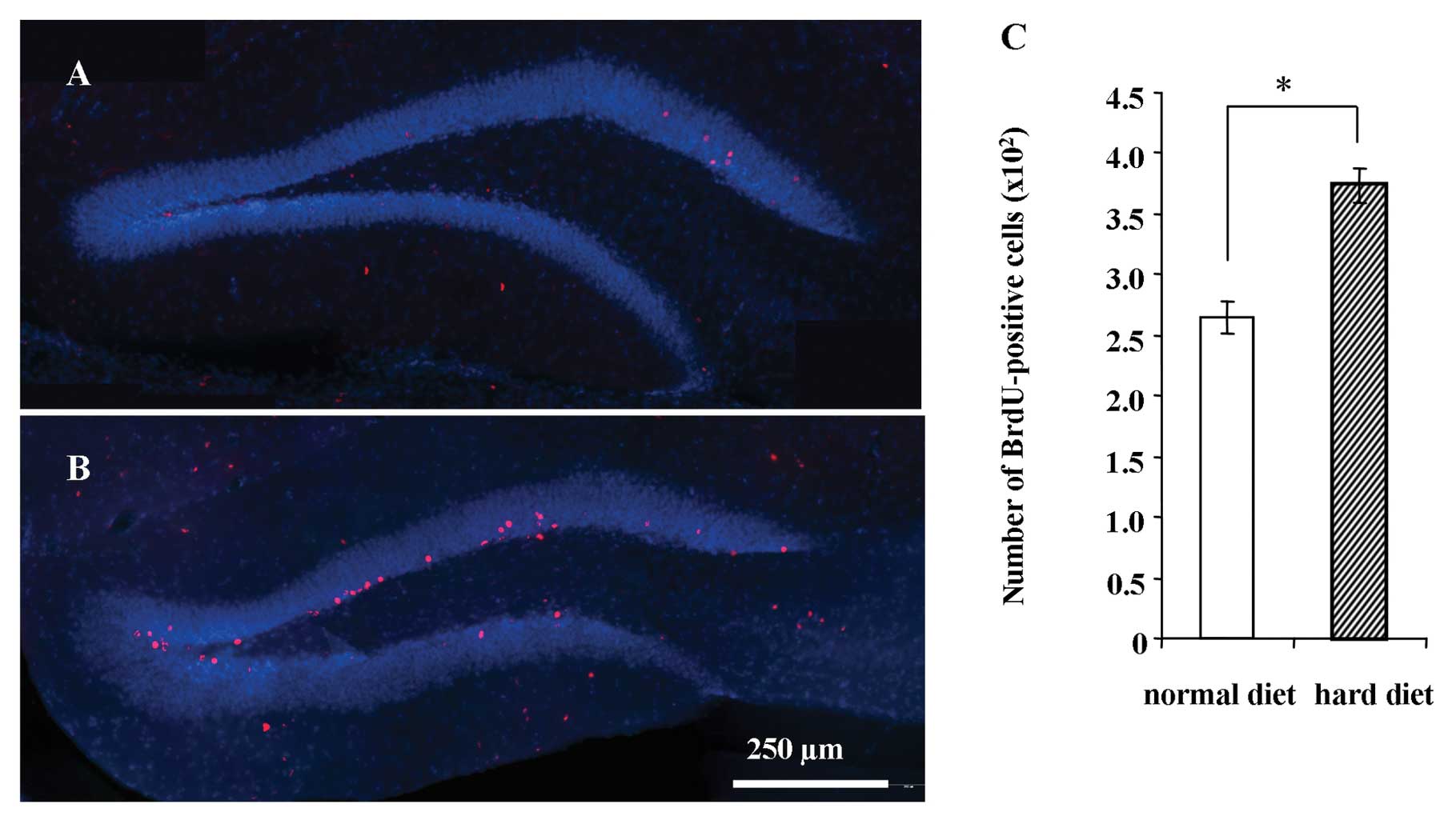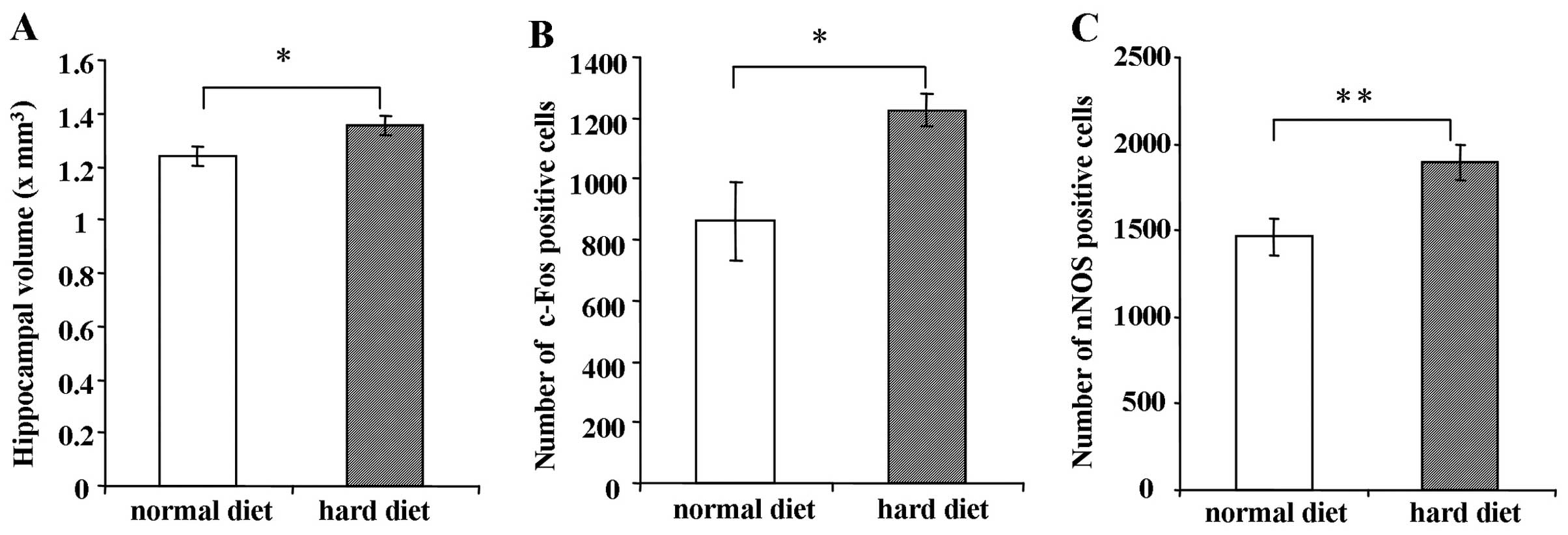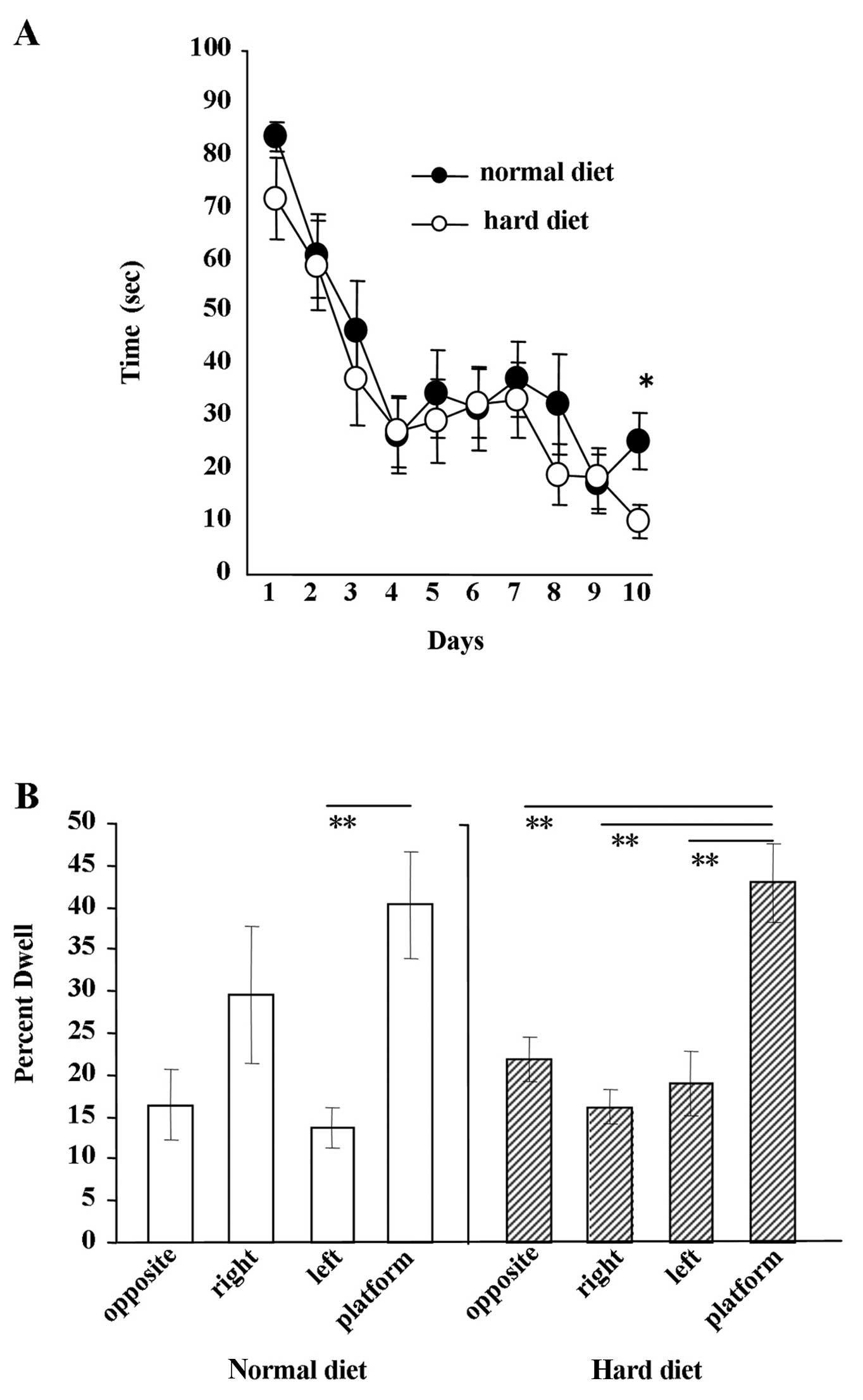Forced mastication increases survival of adult neural stem cells in the hippocampal dentate gyrus
- Authors:
- Published online on: December 18, 2012 https://doi.org/10.3892/ijmm.2012.1217
- Pages: 307-314
Abstract
Introduction
The generation of neurons in the mammalian central nervous system (CNS) was traditionally believed to end by early postnatal life. However, it has been shown that the adult mammalian brain contains self-renewable, multipotent neural stem cells (NSCs) that are responsible for neurogenesis and plasticity in specific regions of the adult brain (1,2). In the hippocampus, newly generated neurons originate from stem cells in the subgranular zone of the dentate gyrus (DG), and neurogenesis continues throughout adult life (3,4). Although the mechanisms by which neurons are generated from stem cells are not yet well known, studies have indicated that the number of newly generated hippocampal neurons in adults is influenced specifically by enriched environments, learning, and voluntary exercise (5,6).
Mastication is a behavior that is closely related with CNS activities. Chewing causes regional increases in cerebral blood flow and neuronal activity in the human brain (7,8). By contrast, it has been shown that reduced mastication and occlusal disharmony impair spatial memory and promote the degeneration of hippocampal neurons (9,10). We, as well as others, have also previously demonstrated that reducing mastication by feeding mice a soft diet inhibits the survival of newly generated neurons in the DG (11,12). However, it remains unknown whether the induction of mastication affects the differentiation, proliferation, or survival of newly generated cells in the adult DG. In this study, we aimed to investigate the effects of forced mastication by hard diet feeding on the differentiation and survival of NSCs in the adult DG.
Materials and methods
Animals
Six-week-old C57BL/6 mice were housed in standard cages. Room conditions were kept at a 12:12-h light/dark cycle and an ambient temperature of 22±2°C. Animals were allowed free access to food and water. All animal procedures were performed in accordance with the guidelines for the Care and Use of Laboratory Animals of Tokushima University Graduate School of Dentistry.
Diet
Mice were fed a standard laboratory diet, MF (Oriental Yeast, Tokyo, Japan). To create a hard diet, MF chow was autoclaved. The hardness of the MF chow was significantly increased by 1.5-fold by autoclave treatment (Fig. 1). Therefore, autoclaved normal diet chow was used as the hard diet to enforce mastication in this study.
Experimental conditions
The time schedule of this experiment is shown in Fig. 2. At 6 post-natal weeks, the animals were placed in standard cages (4 or 5 animals/cage). Control mice were allowed free access to the standard pellet (Fig. 2A). Mice in the experimental group were given free access to a hard diet (autoclaved normal diet) (Fig. 2B). The animals were maintained in each experimental condition for 8 weeks and then received bromodeoxyuridine (BrdU; Sigma-Aldrich, St. Louis, MO, USA) injections (50 mg/g body weight) intraperitoneally once a day for 12 consecutive days. One day after the last BrdU injection, half the mice in each group were given an overdose of anesthetic and perfused transcardially with cold 4% paraformaldehyde in 0.1 M phosphate-buffered saline (PBS) (11). The remaining animals in each group were kept in their respective experimental conditions for 5 additional weeks and were perfused in a similar manner.
Body weight measurement
Throughout the experiment, the nutritional status of the mice was monitored by weighing the mice regularly once a week until the day of sacrifice.
Immunohistochemistry
Mice were sacrificed and perfused transcardially with cold 4% paraformaldehyde in 0.1 M PBS as previously described (11). The brains were removed from the skulls and immersed in the same fixative for 5 h at 4°C with constant rotation followed by washing with PBS overnight at 4°C. Coronal 50-μm hippocampal sections were made using a vibratome and stored at −10°C in cryoprotectant reagent (30% sucrose, 30% ethylene glycol and 0.25 mM polyvinylpyrrolidone in PBS) (11). Vibratome sections were rinsed in 1X Tris-buffered saline (TBS), blocked with 10% normal goat serum (NGS), 1X Triton X-100 in TBS for 1 h, followed by incubation with primary antibodies overnight. The following primary antibodies were used: mouse monoclonal antibodies against neuronal nuclei (NeuN; 1:1,000; Millipore) and neuronal nitric oxide synthase (nNOS; 1:1,000; Santa Cruz Biotechnology, Inc.), rat-monoclonal antibodies against BrdU (1:20; Funakoshi), rabbit-polyclonal antibodies for c-Fos (1:10,000; Santa Cruz Biotechnology, Inc.). For evaluation of the changes in neural proliferation and survival in the DG, the BrdU in vivo labeling protocol was used. BrdU is incorporated only in the cells that are dividing and is integrated in the synthesized DNA enabling them to be detected immunohistochemically. The free-floating brain slices were initially treated with denatured solution (12 N HCl + 1X TBS) and incubated for 30 min at 37°C. After washing in TBS, the sections were incubated for 1 h at room temperature with the appropriate secondary antibodies: anti-mouse Alexa 594 (1:1,000) and anti-rabbit Alexa 488 (1:1,000). Finally, nuclei were stained with 4′,6-diamidino-2-phenylindole (DAPI). Slices were mounted, coverslipped in ProLong® antifade reagent (Invitrogen Life Technologies, Carlsbad, CA, USA) and examined under an epifluorescence microscope.
Volume measurement of the granular cell layer of the DG
Brain slices stained with anti-NeuN antibody were examined and images of the 12 sections were acquired using an epifluorescence microscope. To calculate the DG volume, the area of the granular cell layer was measured using ImageJ software and multiplied by the thickness of the sections (50 μm) according to Cavalieri’s principle (13).
Cell count
The DG was examined under a conventional epifluorescence microscope after the slices were immunohistochemically treated with specific antibodies. A total of 60 slices of 50-μm coronal sections were originally stored in 5 separated tubes containing 12 slices in each tube. Sections from every 200 μm across the whole hippocampus were selected (12 sections from anterior to posterior). BrdU, c-Fos and nNOS labeled cells were manually counted in each section by a blinded observer. A ×20 objective lens was used for all counting (11). The labeled cells within the DG were examined for both the group fed the normal diet and the group fed the hard diet.
Morris water maze
The Morris water maze task was preformed to test spatial learning. The task used a circular pool filled with water containing white ink. A platform was placed in the pool so that it was invisible at water level. The experiment was carried out after the 5 weeks following BrdU injection. Tasks were conducted between 09:00 and 15:00 during the light cycle. After training, mice underwent 3 trials/day for 10 consecutive days. During testing, mice were required to locate the platform, and escape latency time was recorded. Once mice located the platform, they were permitted to remain on it for 10 sec. If mice did not locate the platform within 90 sec, they were placed on the platform for 10 sec and then removed from the pool, as previously described (14,15).
Probe test
Mice were trained in the water maze as described above and then were subjected to a probe test. Each mouse was subjected to a probe test immediately after the final training trial on the 10th day. Before beginning the probe test, the platform was removed from the pool. Mice were released from the quadrant opposite to the previous platform quadrant, and the swimming was tracked for 90 sec, as previously described (16,17).
Real-time PCR
Total RNA was isolated from 21-week-old mice. Mice were sacrificed by an overdose of anesthetic and the hippocampus was dissected in RNAlater (Sigma). Total RNA of hippocampal cells was isolated using the TRIzol reagent (Invitrogen Life Technologies) according to the manufacturer’s instructions. RNA (1 μg) was reverse- transcribed to first-strand cDNA using a PrimeScript™ RT reagent kit (Takara Bio, Inc., Shiga, Japan) according to the manufacturer’s instructions. A Thermal Cycler Dice real-time system (Takara Bio, Inc.) was used for real-time PCR (18–20). The cDNAs were amplified with SYBR® Premix Ex Taq and specific primer pairs for fibroblast growth factor (FGF)-1 (21), FGF-2 (22), epidermal growth factor (EGF) (23), vascular endothelial growth factor (VEGF) (24,25), insulin-like growth factor-1 (IGF-1) (26), nerve growth factor (NGF), neurotrophin-3 (NT-3), brain-derived neurotrophic factor (BDNF), glial cell line-derived neurotrophic factor (GDNF), neuropeptide Y, β-tubulin III, 2′,3′-cyclic-nucleotide phosphodiesterase (CNPase), microtubule-associated protein 2 (Map2), glial fibrillary acidic protein (GFAP), nestin, glutamate receptor 1 (GluR1) (27), glutamate receptor 2 (GluR2) (27), glutamate receptor 3 (GluR3) (27), glutamate receptor 4 (GluR4) (27), N-methyl D-aspartate receptor subtype 2B (NR2B) (28) and glyceraldehyde 3-phosphate dehydrogenase (GAPDH). Primers for NGF, NT-3, GDNF, β-tubulin III, CNPase, Map2, GFAP, nestin and GAPDH were designed with Perfect Real-Time Primer Design software (Takara Bio, Inc.). The primers used in this study are listed in Table I. The PCR conditions were as follows: 10 sec at 95°C, followed by 40 cycles of 95°C for 5 sec and 60°C for 30 sec, and finally, 15 sec at 95°C and 30 sec at 60°C.
Statistical analysis
The results are presented as the means ± SEM. For statistical analysis of the results, the Student’s t-test and ANOVA (Scheffe’s post hoc test) were used to compare the group fed the normal diet with the group fed the hard diet.
Results
Effect of different food textures on mouse growth and dietary intake
Mice fed a normal diet between the ages of 6 and 20 weeks showed a significant difference in body weight compared to the mice fed a hard diet at 11 weeks (Fig. 3A) (P<0.01). However, at all other time-points, the difference in body weight between the groups was not statistically significant. Similarly, the amount of food intake between the group fed the normal diet and the group fed the hard diet showed no significant differences (Fig. 3B).
Proliferation of newly generated cells in the DG
Representative images of BrdU-positive cells in the hippocampus 1 day after the BrdU injection are shown in Fig. 4 for the group fed the normal diet (Fig. 4A) and group fed the hard diet (Fig. 4B). The number of BrdU-positive cells in the DG 1 day after the BrdU injection was not significantly different between the groups (Fig. 4C).
Survival of newly generated cells in the DG
Representative images of BrdU-positive cells in the hippocampus 5 weeks after BrdU injections are shown for the group fed the normal diet (Fig. 5A) and the group fed the hard diet (Fig. 5B). There was a significantly larger number of BrdU-positive cells in the group fed the hard diet compared to the group fed the normal diet 5 weeks after BrdU injection (P<0.001) (Fig. 5C).
Hippocampal volume in mice fed the hard or normal diet
As shown in Fig. 6A, the hippocampal volume of the mice fed the hard diet was significantly larger than the hippocampal volume of the mice fed the normal diet when measured 5 weeks after BrdU injection (P<0.05).
Immunostaining of c-Fos and nNOS in the DG
The number of c-Fos-positive cells in the group fed the hard diet was greater than that in the group fed the normal diet 5 weeks after BrdU injection (Fig. 6B) (P<0.05). Similarly, the number of nNOS-positive cells in the DG was significantly increased in the group fed the hard diet compared to the group fed the normal diet 5 weeks after BrdU injection (Fig. 6C) (P<0.01).
Water maze experiment
The results of the Morris water maze experiment are shown in Fig. 7. The escape latency in each group decreased as the number of trials progressed. No significant difference in the escape latency was found between the group fed the hard diet and the group fed the normal diet from day 1 to 9 (Fig. 7A). Ten days after the beginning of the experiment, we observed a significant difference between the groups (Fig. 7A) (P<0.005). The results of the water maze probe test are shown in Fig. 7B. After 10 days of water maze experiments, the probe test was performed. When mice fed the hard diet were allowed to search for the platform, the period during which the mice focally searched around the former platform location was significantly longer than searches in other locations (P<0.01). By contrast, when mice fed the normal diet were subjected to the probe test, the only difference observed in their searches was between the time spent around the former platform location and the left side of the arena (P<0.05).
Effect of hard diet feeding on mRNA expression of growth factors, neurotrophic factors, NSC markers and receptors in the hippocampus
As is shown in Fig. 8, we analyzed the mRNA expression of growth factors, neurotrophic factors, NSC markers and receptors in the hippocampus between the group fed the hard diet and the group fed the normal diet at the end of the experiment. Real-time PCR analysis revealed that the mRNA expression of the growth factors, FGF-1, FGF-2, EGF, VEGF and IGF-1, was not affected by food texture (Fig. 8A). In addition, the expression of neurotrophic factors (NGF, NT-3, BDNF, GDNF and neuropeptide Y) (Fig. 8B) and NSC markers (β-tubulin III, CNPase, Map2, GFAP and nestin) (Fig. 8C) did not differ between the group fed the hard diet and the group fed the normal diet. While the expression of the receptors, GluR2, GluR3, GluR4 and NR2B (Fig. 8D), was not affected by food texture, GluR1 mRNA expression was significantly increased in the group fed the hard diet (P<0.01).
Discussion
To date, information as to how enforced mastication regulates NSC proliferation and survival in the hippocampus is lacking. To the best of our knowledge, this is the first report to demonstrate that the NSC survival in the hippocampus is increased and spatial memory is improved by forced mastication.
In this study, the normal diet was autoclaved to increase its hardness and thus force the mice to chew. With respect to body weight and food intake (Fig. 3), the growth of the mice was not affected by the autoclaved diet. Therefore, we inferred that the major nutritional components were not markedly different between the normal and the autoclaved normal diet.
We assessed the proliferation of subgranular progenitor cells in the DG of adult mice immediately after consecutive injections of BrdU. We observed that neither the hard diet nor the normal diet caused a change in the number of BrdU-positive cells (Fig. 4). These results indicated that the enforced mastication had no effect on the proliferation of progenitor cells as evaluated by BrdU labeling. Five weeks after the BrdU injections, a decrease in the number of BrdU-positive cells was observed not only in the group fed the normal diet but also in the group fed the hard diet (Fig. 5). However, we found that the number of surviving BrdU-positive cells was significantly increased in the group fed the hard diet compared to the group fed the normal diet (Fig. 5C). Therefore, these data suggest that forced mastication in the group fed the hard diet increased the survival rate of the newly generated cells in the DG.
Hippocampal volume in mice fed the hard diet was significantly increased compared to the mice fed the normal diet (Fig. 6A). Since a number of studies have shown that hippocampal volume affects memory functions (29), forced mastication due to a hard diet may be able to indirectly improve memory. For an assessment of neural activity after forced mastication, the expression of c-Fos in the DG of the group fed the hard diet and the group fed the normal diet was evaluated. It has been shown that the immunostaining of c-Fos is expressed in an activity-dependent manner and has been used as a marker for activated neurons in the DG (30,31). In this study, since c-Fos levels in the DG of the mice fed the hard diet significantly increased compared with the mice fed the normal diet (Fig. 6B), mastication does indeed appear to influence neural activity in the DG.
Nitric oxide (NO) is an intercellular signaling molecule that is involved in several physiological processes (32,33). At least 3 isoforms of NO synthase (NOS) have been identified in the CNS, including endothelial (eNOS), neuronal (nNOS) and inducible (iNOS) forms (32,33). It has been reported that nNOS-knockout increases the survival rate of neuronal cells in the hippocampus (34). However, our results showed that the number of nNOS-positive cells in the mice fed the hard diet was significantly increased (Fig. 6C), and that the number of BrdU-positive cells in the DG of the group fed the hard diet was greater than that in the group fed the normal diet (Fig. 5C). Therefore, the survival of newborn cells during adult neurogenesis in the DG may depend upon other mechanisms in addition to nNOS signaling. For example, sensory-motor information taken from the oral cavity may reach the hippocampus, consequently affecting the neurogenesis rate. Another possibility is that the muscular contractions involved in mastication may increase cerebral blood flow, allowing an increase in the entry of growth factors into the DG that could affect the rate of neurogenesis.
The Morris water maze test was used to examine the effect of induced mastication on spatial learning ability, as previously described (35). Although the group fed the hard diet showed a significant decrease in escape latency only at 10 days compared with the group fed the normal diet (Fig. 7A) (P<0.005), the latency on the probe test after 10 days differed between the group fed the hard diet and the group fed the normal diet (Fig. 7B). This finding indicated that the group fed the hard diet spent significantly more time in the former location of the platform compared to all other locations. For this reason, we suggest that forced mastication can improve spatial learning ability.
We also assessed the effect of a hard diet on the mRNA expression of various growth factors, neurotrophic factors, neuronal stem cell markers, and receptors in the hippocampus by real-time PCR. Although several factors were examined, we observed a small but significant increase in the expression of GluR1 mRNA in the group fed the hard diet compared with the group fed the normal diet (P<0.01). GluRs are synaptic receptors located primarily on the membranes of neuronal cells (36). One of the major functions of GluRs appears to be the modulation of synaptic plasticity, memory and learning (36). Therefore, these changes in the group fed the hard diet may be attributed to the slight increase in GluR1 mRNA expression in the hippocampus (Fig. 8D), as well as in hippocampal volume (Fig. 6A) compared with the group fed the normal diet. However, since these results may be sensitive to the timing of experimentation, further experiments may be required to detect the critical periods of mRNA expression in the hippocampus.
In conclusion, forced mastication alters the survival rate and NSC activity in the DG. In addition, spatial memory was improved in the group fed the hard diet compared to the group fed the normal diet. These results suggest that mastication caused by daily food texture may improve or accelerate the recovery of spatial memory functions in the hippocampus, preventing senile dementia.
Acknowledgements
This study was supported in part by the Grants-in-Aid for Scientific Research (no. 21390548 to M.M. and no. 22592296 to T.H.) from the Ministry of Education, Culture, Sports, Science and Technology of Japan (2010–2014).
References
|
Gage FH: Mammalian neural stem cells. Science. 287:1433–1438. 2000. View Article : Google Scholar : PubMed/NCBI | |
|
Taupin P and Gage FH: Adult neurogenesis and neural stem cells of the central nervous system in mammals. J Neurosci Res. 69:745–749. 2002. View Article : Google Scholar : PubMed/NCBI | |
|
Altman J and Das GD: Autoradiographic and histological evidence of postnatal hippocampal neurogenesis in rats. J Comp Neurol. 124:319–335. 1965. View Article : Google Scholar : PubMed/NCBI | |
|
Kuhn HG, Dickinson-Anson H and Gage FH: Neurogenesis in the dentate gyrus of the adult rat: age-related decrease of neuronal progenitor proliferation. J Neurosci. 16:2027–2033. 1996.PubMed/NCBI | |
|
van Praag H, Kempermann G and Gage FH: Running increases cell proliferation and neurogenesis in the adult mouse dentate gyrus. Nat Neurosci. 2:266–270. 1999. | |
|
Gould E, Beylin A, Tanapat P, Reeves A and Shors TJ: Learning enhances adult neurogenesis in the hippocampal formation. Nat Neurosci. 2:260–265. 1999. View Article : Google Scholar : PubMed/NCBI | |
|
Momose T, Nishikawa J, Watanabe T, Sasaki Y, Senda M, Kubota K, Sato Y, Funakoshi M and Minakuchi S: Effect of mastication on regional cerebral blood flow in humans examined by positron-emission tomography with 15O-labelled water and magnetic resonance imaging. Arch Oral Biol. 42:57–61. 1997. View Article : Google Scholar : PubMed/NCBI | |
|
Onozuka M, Fujita M, Watanabe K, Hirano Y, Niwa M, Nishiyama K and Saito S: Mapping brain region activity during chewing: a functional magnetic resonance imaging study. J Dent Res. 81:743–746. 2002. View Article : Google Scholar : PubMed/NCBI | |
|
Kato T, Usami T, Noda Y, Hasegawa M, Ueda M and Nabeshima T: The effect of the loss of molar teeth on spatial memory and acetylcholine release from the parietal cortex in aged rats. Behav Brain Res. 83:239–242. 1997. View Article : Google Scholar : PubMed/NCBI | |
|
Terasawa H, Hirai T, Ninomiya T, Ikeda Y, Ishijima T, Yajima T, Hamaue N, Nagase Y, Kang Y and Minami M: Influence of tooth-loss and concomitant masticatory alterations on cholinergic neurons in rats: immunohistochemical and biochemical studies. Neurosci Res. 43:373–379. 2002. View Article : Google Scholar : PubMed/NCBI | |
|
Mitome M, Hasegawa T and Shirakawa T: Mastication influences the survival of newly generated cells in mouse dentate gyrus. Neuroreport. 16:249–252. 2005. View Article : Google Scholar : PubMed/NCBI | |
|
Tsutsui K, Kaku M, Motokawa M, Tohma Y, Kawata T, Fujita T, Kohno S, Ohtani J, Tenjoh K, Nakano M, Kamada H and Tanne K: Influences of reduced masticatory sensory input from soft-diet feeding upon spatial memory/learning ability in mice. Biomed Res. 28:1–7. 2007. View Article : Google Scholar : PubMed/NCBI | |
|
Gundersen HJ, Bagger P, Bendtsen TF, et al: The new stereological tools: disector fractionator, nucleator and point sampled intercepts and their use in pathological research and diagnosis. APMIS. 96:857–881. 1988. View Article : Google Scholar : PubMed/NCBI | |
|
Fujioka A, Fujioka T, Tsuruta R, Izumi T, Kasaoka S and Maekawa T: Effects of a constant light environment on hippocampal neurogenesis and memory in mice. Neurosci Lett. 488:41–44. 2011. View Article : Google Scholar : PubMed/NCBI | |
|
Tauber SC, Bunkowski S, Ebert S, Schulz D, Kellert B, Nau R and Gerber J: Enriched environment fails to increase meningitis-induced neurogenesis and spatial memory in a mouse model of pneumococcal meningitis. J Neurosci Res. 87:1877–1883. 2009. View Article : Google Scholar : PubMed/NCBI | |
|
Moser E, Moser MB and Andersen P: Spatial learning impairment parallels the magnitude of dorsal hippocampal lesions, but is hardly present following ventral lesions. J Neurosci. 13:3916–3925. 1993. | |
|
Stackman RW Jr, Lora JC and Williams SB: Directional responding of C57BL/6J mice in the Morris water maze is influenced by visual and vestibular cues and is dependent on the anterior thalamic nuclei. J Neurosci. 32:10211–10225. 2012. View Article : Google Scholar : PubMed/NCBI | |
|
Hasegawa T, Chosa N, Asakawa T, Yoshimura Y, Ishisaki A and Tanaka M: Establishment of immortalized human periodontal ligament cells derived from deciduous teeth. Int J Mol Med. 26:701–705. 2010. View Article : Google Scholar : PubMed/NCBI | |
|
Asakawa T, Chosa N, Yoshimura Y, Asakawa A, Tanaka M, Ishisaki A, Mitome M and Hasegawa T: Fibroblast growth factor 2 inhibits the expression of stromal cell-derived factor 1α in periodontal ligament cells derived from human permanent teeth in vitro. Int J Mol Med. 29:569–573. 2012. | |
|
Hasegawa T, Chosa N, Asakawa T, Yoshimura Y, Fujihara Y, Kitamura T, Tanaka M, Ishisaki A and Mitome M: Differential effects of TGF-β1 and FGF-2 on SDF-1α expression in human periodontal ligament cells derived from deciduous tooth in vitro. Int J Mol Med. 30:35–40. 2012. | |
|
Arnold RS, Sun CQ, Richards JC, Grigoriev G, Coleman IM, Nelson PS, Hsieh CL, Lee JK, Xu Z, Rogatko A, Osunkoya AO, Zayzafoon M, Chung L and Petros JA: Mitochondrial DNA mutation stimulates prostate cancer growth in bone stromal environment. Prostate. 69:1–11. 2009. View Article : Google Scholar : PubMed/NCBI | |
|
Huang CC, Yeh CM, Wu MY, Chang AY, Chan JY, Chan SH and Hsu KS: Cocaine withdrawal impairs metabotropic glutamate receptor-dependent long-term depression in the nucleus accumbens. J Neurosci. 31:4194–4203. 2011. View Article : Google Scholar : PubMed/NCBI | |
|
Qu R, Li Y, Gao Q, Shen L, Zhang J, Liu Z, Chen X and Chopp M: Neurotrophic and growth factor gene expression profiling of mouse bone marrow stromal cells induced by ischemic brain extracts. Neuropathology. 27:355–363. 2007. View Article : Google Scholar : PubMed/NCBI | |
|
Fabel K, Fabel K, Tam B, Kaufer D, Baiker A, Simmons N, Kuo CJ and Palmer TD: VEGF is necessary for exercise-induced adult hippocampal neurogenesis. Eur J Neurosci. 18:2803–2812. 2003. View Article : Google Scholar : PubMed/NCBI | |
|
Cao L, Jiao X, Zuzga DS, Liu Y, Fong DM, Young D and During MJ: VEGF links hippocampal activity with neurogenesis, learning and memory. Nat Genet. 36:827–835. 2004. View Article : Google Scholar : PubMed/NCBI | |
|
Iida K, Del Rincon JP, Kim DS, Itoh E, Nass R, Coschigano KT, Kopchick JJ and Thorner MO: Tissue-specific regulation of growth hormone (GH) receptor and insulin-like growth factor-I gene expression in the pituitary and liver of GH-deficient (lit/lit) mice and transgenic mice that overexpress bovine GH (bGH) or a bGH antagonist. Endocrinology. 145:1564–1570. 2004. View Article : Google Scholar : PubMed/NCBI | |
|
Destot-Wong KD, Liang K, Gupta SK, Favrais G, Schwendimann L, Pansiot J, Baud O, Spedding M, Lelièvre V, Mani S and Gressens P: The AMPA receptor positive allosteric modulator, S18986, is neuroprotective against neonatal excitotoxic and inflammatory brain damage through BDNF synthesis. Neuropharmacology. 57:277–286. 2009. View Article : Google Scholar | |
|
Boon WC, Diepstraten J, van der Burg J, Jones ME, Simpson ER and van den Buuse M: Hippocampal NMDA receptor subunit expression and water maze learning in estrogen deficient female mice. Brain Res Mol Brain Res. 140:127–132. 2005. View Article : Google Scholar : PubMed/NCBI | |
|
Ystad MA, Lundervold AJ, Wehling E, Espeseth T, Rootwelt H, Westlye LT, Andersson M, Adolfsdottir S, Geitung JT, Fjell AM, Reinvang I and Lundervold A: Hippocampal volumes are important predictors for memory function in elderly women. BMC Med Imaging. 9:172009.PubMed/NCBI | |
|
Kee N, Teixeira CM, Wang AH and Frankland PW: Preferential incorporation of adult-generated granule cells into spatial memory networks in the dentate gyrus. Nat Neurosci. 10:355–362. 2007. View Article : Google Scholar : PubMed/NCBI | |
|
Ahn SN, Guu JJ, Tobin AJ, Edgerton VR and Tillakaratne NJ: Use of c-fos to identify activity-dependent spinal neurons after stepping in intact adult rats. Spinal Cord. 44:547–559. 2006. View Article : Google Scholar : PubMed/NCBI | |
|
Bredt DS, Hwang PM and Snyder SH: Localization of nitric oxide synthase indicating a neural role for nitric oxide. Nature. 347:768–770. 1990. View Article : Google Scholar : PubMed/NCBI | |
|
Brenman JE and Bredt DS: Synaptic signaling by nitric oxide. Curr Opin Neurobiol. 7:374–378. 1997. View Article : Google Scholar | |
|
Fritzen S, Schmitt A, Köth K, Sommer C, Lesch KP and Reif A: Neuronal nitric oxide synthase (NOS-I) knockout increases the survival rate of neural cells in the hippocampus independently of BDNF. Mol Cell Neurosci. 35:261–271. 2007. View Article : Google Scholar : PubMed/NCBI | |
|
Sharma S, Rakoczy S and Brown-Borg H: Assessment of spatial memory in mice. Life Sci. 87:521–536. 2010. View Article : Google Scholar : PubMed/NCBI | |
|
Peng S, Zhang Y, Zhang J, Wang H and Ren B: Glutamate receptors and signal transduction in learning and memory. Mol Biol Rep. 38:453–460. 2011. View Article : Google Scholar : PubMed/NCBI |



